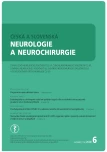Endoscopic lavage of intraventricular haemorrhage in premature newborns
Authors:
T. Radovnický 1; P. Hitka 2; M. Sameš
Authors‘ workplace:
Neurochirurgická klinika Fakulty zdravotnických studií UJEP a Masarykovy nemocnice v Ústí nad Labem, o. z
1; Neonatologická klinika Fakulty zdravotnických studií UJEP a Masarykovy nemocnice v Ústí nad Labem, o. z.
2
Published in:
Cesk Slov Neurol N 2020; 83/116(6): 655-658
Category:
Letter to Editor
doi:
https://doi.org/10.48095/cccsnn2020655
Sources
1. Whitelaw A. Intraventricular haemorrhage and posthaemorrhagic hydrocephalus: pathogenesis, prevention and future interventions. Semin Neonatol SN 2001; 6 (2): 135–146. doi: 10.1053/siny.2001.0047.
2. Vassilyadi M, Tataryn Z, Shamji MF et al. Functional outcomes among premature infants with intraventricular hemorrhage. Pediatr Neurosurg 2009; 45 (4): 247–255. doi: 10.1159/000228982.
3. du Plessis AJ. The role of systemic hemodynamic disturbances in prematurity-related brain injury. J Child Neurol 2009; 24 (9): 1127–1140. doi: 10.1177/0883073809339361.
4. Limbrick DD, Mathur A, Johnston JM et al. Neurosurgical treatment of progressive posthemorrhagic ventricular dilation in preterm infants: a 10-year single-institution study. J Neurosurg Pediatr 2010; 6 (3): 224–230. doi: 10.3171/2010.5.PEDS1010.
5. Wellons JC, Shannon CN, Kulkarni AV et al. A multicenter retrospective comparison of conversion from temporary to permanent cerebrospinal fluid diversion in very low birth weight infants with posthemorrhagic hydrocephalus. J Neurosurg Pediatr 2009; 4 (1): 50–55. doi: 10.3171/2009.2.PEDS08400.
6. Simon TD, Hall M, Riva-Cambrin J et al. Infection rates following initial cerebrospinal fluid shunt placement across pediatric hospitals in the United States. Clinical article. J Neurosurg Pediatr 2009; 4 (2): 156–165. doi: 10.3171/2009.3.PEDS08215.
7. Notarianni C, Vannemreddy P, Caldito G et al. Congenital hydrocephalus and ventriculoperitoneal shunts: influence of etiology and programmable shunts on revisions. J Neurosurg Pediatr 2009; 4 (6): 547–552. doi: 10.3171/2009.7.PEDS08371.
8. Whitelaw A, Evans D, Carter M et al. Randomized clinical trial of prevention of hydrocephalus after intraventricular hemorrhage in preterm infants: brain-washing versus tapping fluid. Pediatrics 2007; 119 (5): e1071–e1078. doi: 10.1542/peds.2006-2841.
9. Schulz M, Bührer C, Pohl-Schickinger A et al. Neuroendoscopic lavage for the treatment of intraventricular hemorrhage and hydrocephalus in neonates. J Neurosurg Pediatr 2014; 13 (6): 626–635. doi: 10.3171/2014.2.PEDS13397.
10. Thomale UW, Cinalli G, Kulkarni AV et al. TROPHY registry study design: a prospective, international multicenter study for the surgical treatment of posthemorrhagic hydrocephalus in neonates. Childs Nerv Syst ChNS Off J Int Soc Pediatr Neurosurg 2019; 35 (4): 613–619. doi: 10.1007/s00381-019-04077-4.
Labels
Paediatric neurology Neurosurgery NeurologyArticle was published in
Czech and Slovak Neurology and Neurosurgery

2020 Issue 6
Most read in this issue
- Progressive supranuclear palsy
- Suprascapular neuropathy
- Flexible endoscopic evaluation of swallowing vs. screening tests for dysphagia and their effect on the final outcome in post-acute stroke patients
- COVID-19 associated encephalopathy responding to treatment with intravenous immunoglobulins
